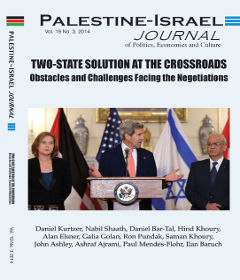The current round of Israeli-Palestinian negotiations is scheduled to end on April 29. Many observers believe that this is the last opportunity to try to advance a resolution of the conflict through bilateral Israeli-Palestinian negotiations.
U.S. Secretary of State John Kerry, backed by President Barack Obama, deserves credit for his determination and creativity in attempting to bring the two sides together despite all of the skepticism which greeted his efforts. The Council of the European Union also deserves credit for having issued its December 2013 policy statement on the Middle East, with its inducements to the two parties, alongside the publication of its guidelines against economic support for Israeli enterprises in settlements over the Green Line. There is no doubt that this was one of the contributing factors to the resumption of negotiations.
Clearly, the continuation of settlement building, both in the West Bank and in East Jerusalem, is one of the primary obstacles to a realistic agreement. A second unnecessary obstacle is the new demand that the Palestinians recognize Israel as the state of the Jewish people, a demand that was not made of either the Egyptians or the Jordanians. Both the Israeli and the Palestinian Declarations of Independence refer to United Nations General Assembly (UNGA) Resolution 181 (the Partition Plan), which calls for the establishment of two "Independent Arab and Jewish States" in Mandatory Palestine, and the Palestine Liberation Organization (PLO) has already recognized the state of Israel in the 1993 Declaration of Principles.
Given the hesitations of the leadership of the two sides, we believe that the Americans should not limit themselves to the role of facilitator but put on the negotiating table a paper containing their positions on all of the core issues.
This may be one of the last opportunities to make progress toward a viable two-state solution, and we urge all of the parties concerned to seize this opportunity. The alternative idea of a one-state solution is not a realistic alternative, but rather a recipe for either an Israeli-dominated apartheid-like regime or violent chaos.
This issue of the Palestine-Israel Journal analyzes the obstacles to successful negotiations, and offers recommendations about how to overcome them. If the current negotiations do not produce results, ideas for what should follow are also proposed, including a two-phase agreement, an internationalization of the quest for a resolution of the conflict with the involvement of the Arab Peace Initiative, and a new UN Security Council Resolution to update UN Security Council Resolutions 242 and 338.
Public opinion polls indicate that a majority of Israelis and Palestinians continue to support a two-state solution based on a Palestinian state in the West Bank, Gaza and East Jerusalem alongside the state of Israel, with mutually agreed-upon land swaps on a 1:1 basis. What we need now is leadership that will translate that support into reality on the ground.

